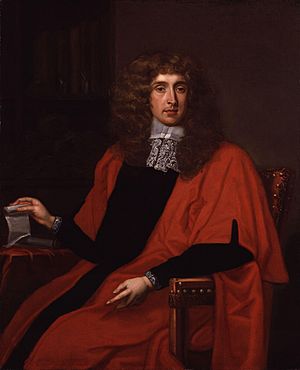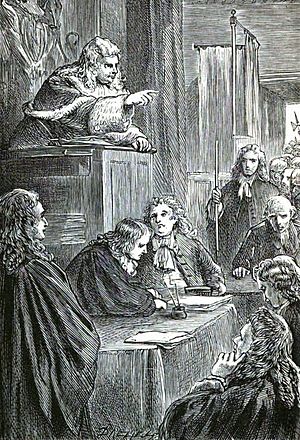Bloody Assizes facts for kids

The Bloody Assizes were a series of important trials held in England starting in August 1685. These trials took place after the Battle of Sedgemoor, which was the final battle of the Monmouth Rebellion. This rebellion was an attempt to overthrow King James II. The trials were known for being very strict and harsh.
Contents
What Were the Bloody Assizes?
The Bloody Assizes were special court sessions. They were set up to punish people who had taken part in the Monmouth Rebellion. These trials began in Winchester on August 25, 1685.
The Judges of the Assizes
There were five main judges who led these trials. The most well-known was Lord Chief Justice George Jeffreys. He was the head judge. The other judges included Sir William Montague, Sir Robert Wright, Sir Francis Wythens, and Sir Creswell Levinz.
Trials Begin in Winchester
More than 1,000 rebels were waiting in prison for their trials. The first trials started in the Great Hall of Winchester Castle on August 26. One of the first people tried was an elderly woman named Alice Lisle. She was found guilty of helping the rebels. Even though the jury was hesitant, the law said she was just as guilty as the rebels themselves. She was sentenced to death. Her sentence was later changed from burning to beheading. This punishment happened in Winchester on September 2, 1685.
The Courts Travel the West Country
After Winchester, the court moved through the West Country of England. They held trials in several towns where the rebellion had been strong. These places included Dorchester (on September 5), Exeter (on September 14), and Taunton (on September 17). The trials finished in Wells on September 23, 1685.
Punishments and Outcomes
More than 1,400 prisoners faced the court. Most were found guilty and sentenced to death. However, fewer than 300 people were actually executed by hanging. In Taunton, for example, 144 people were hanged. Their bodies were displayed around the county. This was done to show people what would happen if they rebelled against the king.
Many other rebels were not executed. About 800 to 850 men were sent away to the West Indies. They were sent there to work as cheap labor. This was because they were worth more alive as workers than dead. Some prisoners were kept in jail to await more trials. However, many of them died in prison from sickness, like 'Gaol Fever' (typhus). This sickness was common in the dirty prisons of that time.
What Happened to Judge Jeffreys?
After the trials, Judge Jeffreys went back to London. He reported to King James. The King was pleased with Jeffreys' work. He rewarded Jeffreys by making him Lord Chancellor. Jeffreys was only 40 years old at the time. He became known as "the hanging judge" because of how many people he sentenced to death.
Later, after the Glorious Revolution in 1688, King James II lost his throne. Judge Jeffreys was then put in the Tower of London. He died there in 1689. His death was likely due to ongoing health problems.
See also
- Captain Blood (1935 film)


